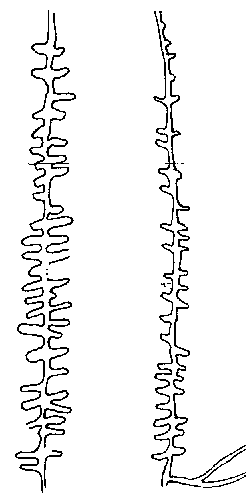 |
Science Frontiers ONLINE No. 56: Mar-Apr 1988 |
|
|
Ubiquity Of American Archeological Anomalies
 An inscribed stone from Connecticut. Interpreting the marks as ogam writing; Face 1 (left) reads up, Face 2 (right) reads down. Adapted from the Bulletin of the Early Sites Research Society and the Occasional Publications of the Epigraphic Society. |
The conventional journals, such as American Antiquity and the American Anthropologist disdain such discoveries. One place to find them is in the Occasional Publications of the Epigraphic Society. The 1987 compilation of these papers is at hand, and it is chock full of fascinating things. The following data are from Volume 16 for 1987.
Ancient coins. A bronze coin of the ancient Greek city of Amisos was found about six years ago by Doyle Ellis, who was searching for gold with a metal detector in the channel of the Snake River in Idaho. It was deeply embedded in the gravel.
In a small Indian mound at Deer Creek, near Chilicothe, Ohio, a Numidian bronze coin was recently uncovered. It has a BC date.
"Oddly, those same coins, regarded in the Old World as artifacts of the highest importance, are never regarded at all by archeologists in America, who blithely declaim the 'absence' of Old World artifacts in America." (p. 14)
Ogam inscriptions. A stone inscribed in ogam was recently reported from Connecticut. (See: the Bulletin of the Early Sites Research Society, vol. 12, 1985.) B. Fell translates the ogam as follows:
"In this small stone lies the power of averting sickness/The ogam protects from the debilitation of the Evil Eye."
In Wyoming and extraordinary rebus/ ogam panel was discovered in 1986. An excellent photograph of the inscription may be found in the Occasional Papers in an article by R.E. Walker. (p. 304)
Comment. The implication of these ogam inscriptions is that North America was visited by Celtic peoples long before Columbus.
Nos Ancetres Chinois. This article. by M. Chatelain, happens to be in French, which is too bad because Americans are generally poor linguists. Anyway, the article summarizes evidence for ancient Chinese visits to North America. (p. 290)
Above we have only a sampling from this 334-page volume. We must pass over the Oklahoma runes, stick-chart naviga tion in Micronesia, and the course in "fantastic archeology" at Harvard, etc.
Reference. For more background on this subject, see our handbook Ancient Man. Ordering information here.